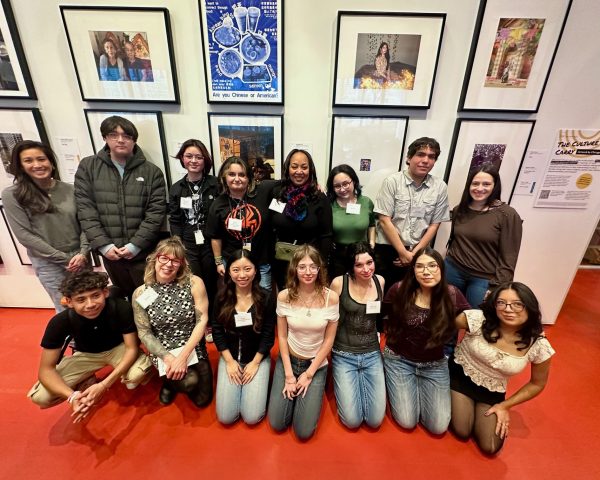Teen driving culture: Dealing with outside elements
Mr. Mitchell, director of the driver’s education program, teaches students how to complete a three-point turn before going out to range.
Driving. The word can convey a range of emotions to one’s mind. Fear, excitement, freedom. Getting a license represents different things for different people.
For Isaiah Martinez, Div. 880, getting his license proves to his family that he can carry on a big responsibility.
“My family didn’t think I was ready but I proved them wrong, so it was more of an ‘I told you so’ moment,” Martinez said.
For Cecilia Barrera, Div. 851, getting her license allows her to travel on her own, and become more independent.
“I would struggle with my mom having to take me everywhere and if she couldn’t, then I couldn’t go out,” Barrera said.
According to Mr. Mitchell, director of the Driver’s Ed department, Lane is the largest center for Driver’s Education in the state of Illinois. Approximately 2,400 students are processed through the center every year, with 1,400 students coming from outside of Lane.
The Driver’s Education program has progressed over the years, in terms of a more focused curriculum, according to Driver’s Ed teacher Mr. Polki. One challenge, however is the effect of budget cuts on classroom materials, specifically the simulators.
“We could do so much more with better simulators, new simulator programs,” Driver’s Ed teacher Ms. Onken said. “The technology that we are dealing with here is 10 years old. It is outdated and it is glitchy.”
The cost needed to replace the simulators is approximately $150,000, according to Onken. This has been a challenge, especially since the board continues to cut the Driver’s Ed budget.
The Driver’s Ed department has been trying to replace the simulators for about five years, but there have not been any improvements.
“To be quite honest, they [CPS] don’t want to spend that kind of money on Driver’s Ed,” Onken said. “We do the best we can.”
According to Onken, the value of education that students receive from a public driving school differs from a private driving school.
“We do so much more here than what any other driving school does,” Onken said. “We talk about road rage, we talk about distracted driving, we talk about things that we can do to try and be a better person as a driver. Private driving schools don’t have time to touch on that.”
While all CPS high schools offer Driver’s Education in a classroom environment, Lane is one of 19 range centers to choose from, according to Mitchell.
“The classroom gives you tips on how to drive, shows you what the signs are, and how to go about things,” Samantha Latz, Div. 969 said. “Range allows you to put that into practice and actually learn how to drive a vehicle.”
Times have changed, in terms of teenagers driving, according to Polki.
“I still question whether the kids today are ready to drive when they are 16,” Polki said. “There’s less and less focus for the younger generation on driving as there was, say when I started driving in 1965.”
The number of teen drivers has hit a record low. According to the Federal Highway Administration, America now has the fewest number of 16-year-olds driving than any other time since the 1960s.
There are several components that have contributed to this trend. One main factor is the easy access of public transportation within the city.
“I think here in the Chicagoland, we have a great CTA system,” Onken said. “If you’re coming to this school, you are already a commuter; you already deal with traffic and schedules and things like that. It’s much easier on the bus, on the train. I think that’s always played a part here.”
Financial circumstances also play a role in teens waiting longer to get their license.
“I think also financially, it’s expensive,” Onken said. “Whether it’s insurance, whether it’s just gas or the car itself, times are tough.”
Some students also face challenges with their parents, as some are too nervous to let them drive, according to Polki. If students ever encounter this scenario, he simply tells them to pull over and let their parents drive back home.
“We want it to be a pleasurable experience, not one of tension,” Polki said.
This trend leads to negative effects, according to Onken.
“No matter when you start to drive, you’re still going to be inexperienced,” Onken said.
“Age doesn’t give you that experience you need for driving; that’s a downfall. We have limitations or guidelines set to those who are under 21, but what if you wait until after 21 and you’ve never driven. There’s no restrictions for you. So I definitely see that as a downfall.”
A vast majority of Driver’s Ed students have expressed interest in learning how to drive and have learned valuable life skills, according to the Drivers Ed department.
“Driving itself, the skill is so small,” Onken said. “It’s dealing with these outside elements; it’s dealing with making decisions.”
Your donations directly fund the Lane Tech student journalism program—covering essential costs like website hosting and technology not supported by our school or district. Your generosity empowers our student reporters to investigate, write, and publish impactful stories that matter to our school community.
This website is more than a publishing platform—it's an archive, a research tool, and a source of truth. Every dollar helps us preserve and grow this resource so future students can learn from and build on the work being done today.
Thank you for supporting the next generation of journalists at Lane Tech College Prep!

Clarissa Corral is a senior at Lane. She is very passionate about writing and journalism is something that she would like to pursue in college. Her dream...




